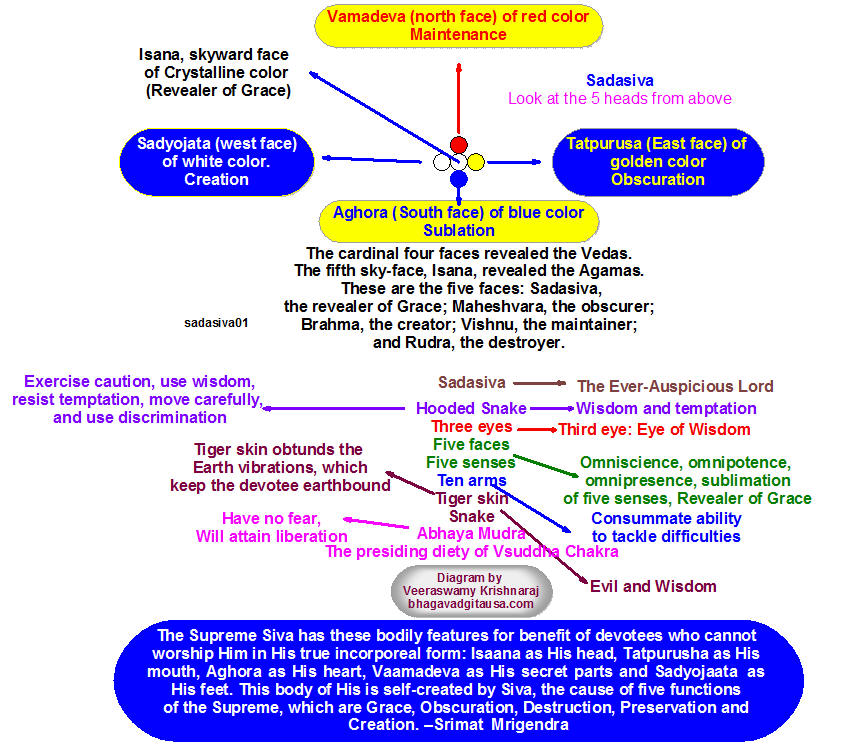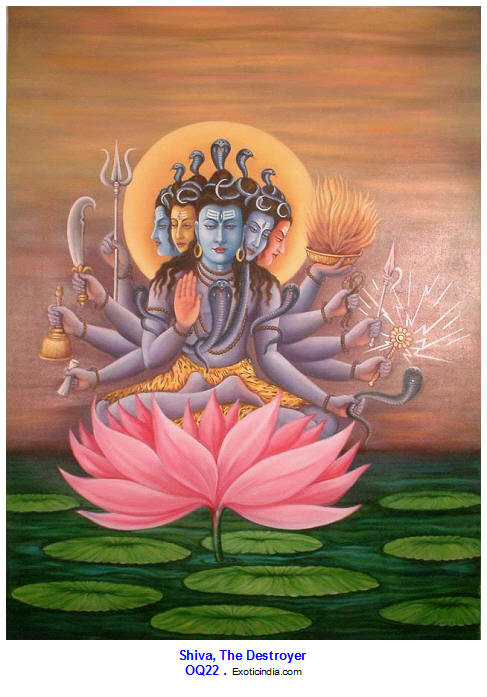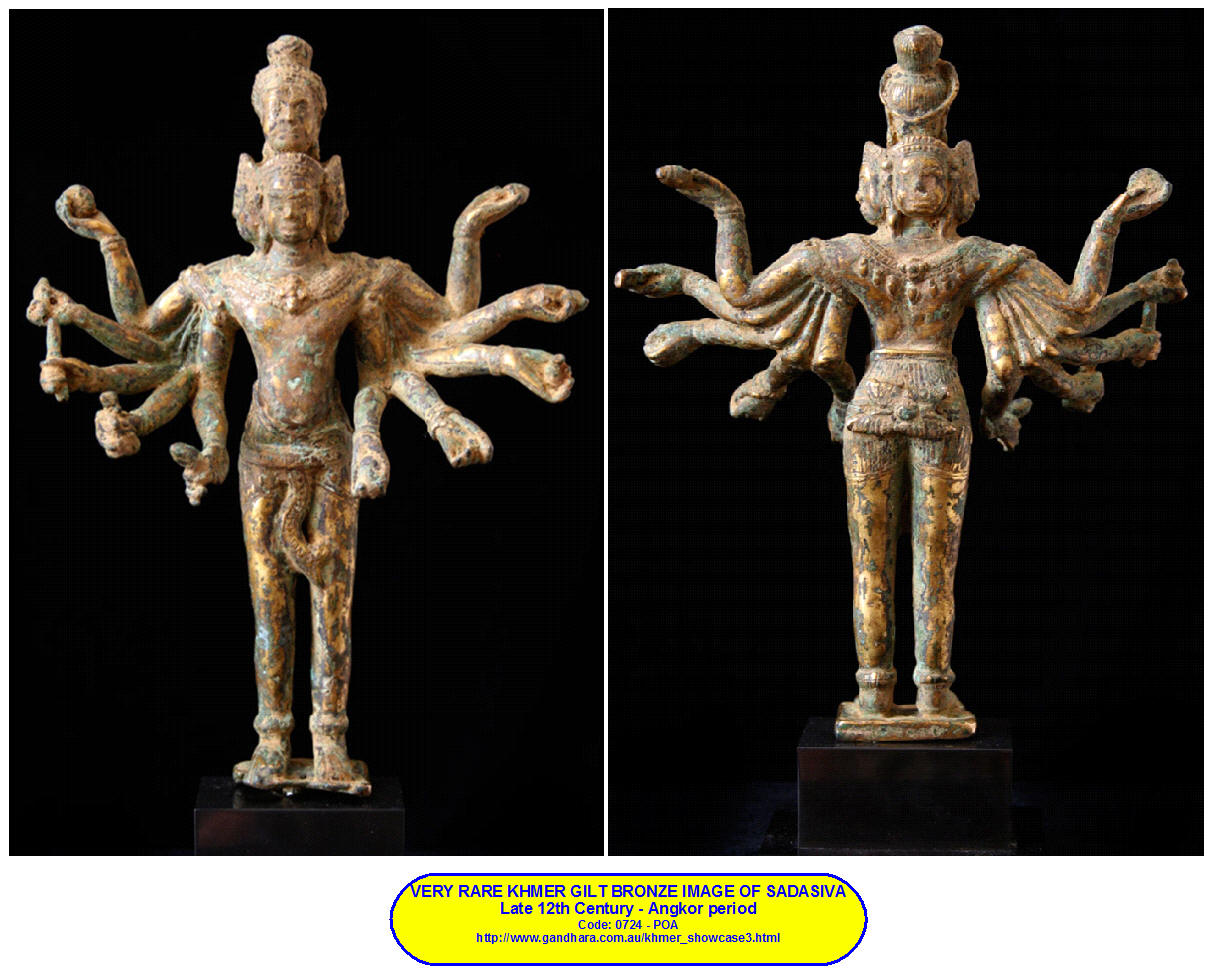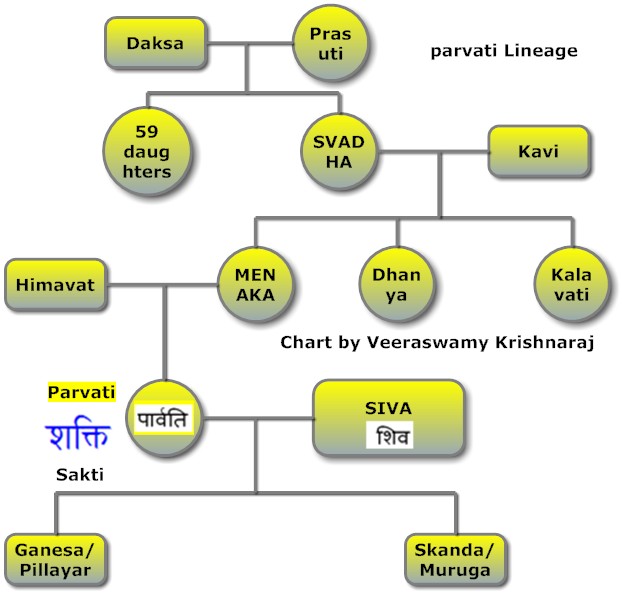
Bhagavad-Gita:Chapters in Sanskrit
(All 18 chapters in Sanskrit, Transliteration, and Translation.)
Bhagavadgita in English
Veeraswamy Krishnaraj



எங்கள் பெருமான் (48)
நிறங்கள் ஓர் ஐந்து உடையாய் (49) from Tiruvasakam by
Manickavasagar.
Sadasiva is of five colors: Isa of crystalline color; Vamadeva of red color; Aghoram of blue color; Sadyojata of white color and Tatpurusha of golden color. Five heads with five colors.
Insert: Credit: Exoticendia.com
The five faces of Sadasiva represent five elements: Earth, Water, Fire, Wind, and Ether. The body represents five elements: From the foot to the knees, it is earth; from the knees to the navel, it is water; from the navel to the throat it is fire; from the throat to the mouth it is wind; from the mouth to the crown it is ether. Dvādasāntam is the mystic center 12 inches above the crown. Human consciousness is a derivative of Chaitanya, divine consciousness. In order that it merges with Chaitanya, the priest drives his Prana through Susumna Nadi and Brahma Randhra (Anterior Fontanel area) to an imaginary locus, Dvadasantam. Dva + Dasa + Antam = two + ten + edge = (locus) 12 inches away.
The ritual:
The priest performs purification of his body's five elements from the toes to his crown and enters the supreme Yogic center, Dvādasāntam (Dvadasantam) where he is suffused with the effulgence of Siva. Sanctification of the body follows purification. The Divine Consciousness descends from above the crown into the body of the priest, who exhales and transfers this energy into the heart of the image. Yogis have to be pure externally and internally. Our body is made of five afore-mentioned elements; thus, purificatory rites are carried out by Mantras, Mudras....
The East Face (facing front) is of pearly lustrous complexion with three eyes and a crescent moon on the crown; the Devis, Annapurna, Bhuvanesvari, Lakshmi, Lalita, Mahalakshmi, Nitya, Padma, Sarasvati, Shulini, Triputa, Tvaita, Vagvadini, Vajraprastarim received Mantras and appropriate rites from the East Face. The East Face represents Purvamnaya, East Doctrine, which is concerned with creation, Mantra Yoga Marga, and 24 Tattvas. Purvam + Aamnaaya = East + tradition, sacred Text, legend. Each mantra has its guardian deity, who confers benevolence to the chanter. All the lesser gods and goddesses are the emanations of Siva and Sakti.
The South Face of yellow complexion with three eyes revealed Mantras and rites to Bhairva, Dakshinamurti, Mahaprasadamantra, Manjughosa, Mritasanjivanividya, Mrityunjaya, Prasadasadasiva, Vatuka. Dakshina-amnaya, South Doctrine, is concerned with maintenance, Bhakti Marga, and 25 principles or Tattvas.
The West Face of the complexion of clouds revealed the Mantras and rites to Agni, Candra (Vidhu ), Dikpalas, Ganesha, Garuda, Gopala, Hanuman, Harihara (insert: Hari is blue face and Hara is white face; This is One God, part Vishnu and part Siva. credit exoticindia.com) Krishna, Narayana, Nrishimha, Ramacandra, Suras, Surya, Vamana, Varaha, Vishnu, Yama. Paschima-amnaya, the West Doctrine, is concerned with destruction, Karma Marga, and 32 Tattvas.

The North Face of blue color (Different texts differ in the color attribution to the heads of Sadasiva.) with three eyes revealed Bhadrakali, Bagalamukhi, Chhinnamasta, Dakshinakalika, Dhumavati, Durga, Ekajata, Gauri, Guhyakah, Jayadurga, Katyayani, Mahakali, Mahishamardini, Matangi, Navadurga, Nilasarasvati, Pratyangira, Smashanakalika, Taritni, Ugratara, Vashuli, Vishalakshi their rites and Mantras. Uttara-amnaya, the North Doctrine, is concerned with Grace and Compassion of Sadasiva, Jnana Marga and 36 Tatttvas. Go to Tattvas-36
The Sky Face of white complexion revealed Annapurnabhairavi, Bhairavi, Bhuvaneshibhairavi, Malini, Pancami, Shodashi, Shatkutabhairavi, Shrimattripurasundari, Smashanabhairavi, Tripurabhairavi, Tripureshi, Valavala their rites and mantras. Urdhva-amnaya is the High Doctrine which extols the Brahman in his fullness. The High doctrine is kept as the most secret doctrine, while Vedas, Puranas and Sastras can be revealed. Saiva and Sakta Agamas remain secret among the Kaulas. Urdhva-amnaya is the most secret one of all and came most directly from Siva himself.
The Amnayas (Doctrines) lead one to liberation-*. He who knows all the Amnayas is Siva himself. Urdhavamnaya is the most exalted doctrine and Law of all doctrines: it is the musk among fragrances, Kanchi among cities, head among the limbs, Brahmana among castes, King among men, Sanyasa among Asramas, swan among the birds, cow among the four-legged animals, sandal-wood among trees, gold among metals, gem among precious stones, sweetness among tastes, Asvamedha among sacrifices, Mount Meru among mountains, Ganga among rivers, Kasi (the old Benares or Varnasi) among Tirthas (sacred places), Sun among the luminary objects, and Vishnu among Gods. It has to come from the mouth of a Guru. The Mantra is Hamsa. Go to Mantra OM NAMASIVAYA <<<<click>>>>>
The Concealed sixth Face of many colors taught Asana, Balidana, Devatasthana, Mala, Mantrasiddhi, Naivedya, Purashcarana, Sadhana, Yantra.
Lineage is as follows: Sambhu, Sadasiva (portfolios: creation, maintenance, sublation), Anugraha/favor/Grace, Obscuration/disfavor/Tatpurusa/Nigraha, Isa, Rudra, Vishnu, Brahma. Vishnavites believe that Brahma is lotus-born of Vishnu and Rudra is Brahma-born.
Agamas, the Egalitarian Manual of Philosophy, Means, and Realization
Saiva Agamas "came down" from the mouth of Siva ( all five faces). They were revealed by Siva to Devi and his son Kartikeya. That is the Guru-pupil transmission of wisdom. The pupils (Devi and Kartikeya) assumed the role of Guru and answered the questions of Siva; that is Nigama, conclusion. Vedas of Brahmanic schools were prohibited reading and hearing in the olden days for non-Brahmanas and women; but Agamas had no restrictions: they were available for servants, maids, women, Sudras and anyone who wanted to hear or read. There are 28 Agamas and 108 Upagamas (minor). The Saktas have 77 Saktagamas. They are called Sadhana Shastras: anyone can seek happiness (Bliss) by following Agamic prescriptions. The Tantra Shastra have three parts: Sadhana, Siddhi and Darshana. There are no hypotheticals, arguments, vacillations and conflicts. Agamas came down from Siva who is above all these mundane inefficiencies. He is the Speaker, the Authority, the Yogin of yogins, and with that introduction, which is audaciously presumptuous on my part, where is the need to argue? Siva's presentment of Agamas is egalitarian in its outlook; You can take it or leave it, no problems: such is the strength of Agamas. Will is the motivator; Agamas provide the rest: Sadhana, the means; Dharshana, the philosophy; and Siddhi, the realization, which is of course dependent on one's effort. Agamas are inclusive of mantras, Tantras and Yantras.
Egalitarian God Siva gave away Agamas free for anyone willing to seek liberation. Vedic purists and adherents of human nature afflicted with three Gunas (qualities) of Virtue, Passion, and Darkness (Sattva, Rajas and Tamas) suppressed their virtue and augmented their passion and darkness by prohibiting the Sudras and Women from listening to, uttering or reading the Vedas. Would you not be upset if a priest forbids certain people to read the Bible? This prohibition did not work very well. The genius of the Hindu mind in other lesser castes flourished in the likes of Kamban, Nammalvar, Valluvar... all belonging to Sudras or less. They stratified the society into four divisions (Manu was the Head Honcho among them.): Barhmanas, Ksatriyas, Vaisyas and Sudras (priests, warriors, traders and menial workers). Vivekananda says that gods and kings gave away their sacred texts free of charge, while Brahmanas found nickels and dimes in their rituals, which were their dispensation to the people. In Srivaishnava tradition, an Uttama Bhakta (true devotee of Vishnu) does not discriminate against people on the basis of their heredity, environment, circumstances, race, color, creed... To be truthful, there are very few of them. Dr. Ambedkar, educated in Columbia University, NY was even below the four classes and was christened pejoratively but politely a Dalit--the Oppressed. The real stinging word is Pariah. He wrote the constitution of India. He was fed up with the Manu's system of caste stratification and its attendant daily humiliations, bid goodbye to Hinduism, burned a copy of the Book the Laws of Manu, and joined ranks with the 'atheistic' Buddhists. The Hindus could not let go of the Buddha, according to the Buddhists. They got him back into their fold. The Buddha, the Buddhists claim, was co-opted by the Hindus as one of Vishnu's Avatars. If one delves into Hinduism, it is a hodgepodge of anything and everything a human mind can imagine: that is the view of detractors. They are right to a certain extent. Hinduism is a repository of all latent and expressed ideas of man. You cannot find any idea in other religions that was not already present and elucidated in Hindu sacred texts. The co-optive Hindus as said by the Buddhists declared Buddhism was a branch of the trunk of Hinduism and its sap is Hinduism.
The Supreme Siva has these bodily features for benefit of devotees who cannot worship Him in His true incorporeal form: Isaana as His head, Tatpurusha as His mouth, Aghora as His heart, Vaamadeva as His secret parts and Sadyojaata as His feet. This body of His is self-created by Siva and is the cause of five functions of the Supreme, which are Grace, Obscuration, Destruction, Preservation and Creation. Srimat Mrigendra
Agama and Nigama are the two arms of Siva and Sakti, by which they raise the children (sadhakas, devotees) so that the latter can pick the fruits from the Vedic tree of wisdom and liberation.
There have been two parallel systems of doctrine and philosophy from time immemorial: Vedic and Agamic. Agamas have support in Vedas. Mohenjo-daro excavations show the seed of doctrine of Pati-Pasu-Pasa trilateral relationship was in evidence, for Siva was seated on the bull surrounded by animals. In Christian terms, Pati is the shepherd. Pasu is the spiritually unenlightened soul (compared to an animal or flock, Pasu = cow or kine), and Pasa is the Faustian bond that holds the kine to the post of Samsara, worldly or Faustian life. Siva is Pasupati, the chief, who has the Will, Knowledge, wherewithal and action-power (Iccha, Jnana and Kriya) to lead the flock to liberation. The domestic and wild animals from a meekly lamb to a carnivorous tiger that flock around Siva in a mellow and tranquil mood and in full tolerance and acceptance of each other indicate that Siva has the power to take them away from their animalistic nature to human and eventually to a divine nature. The Tantrics call this transformation the goal of man: Going from Pasu Bhava to Vira bhava and to Divya Bhava-- from the nature of an animal to a human and to a divine).
Jesus Christ is a lamb and a lion in one. When you look at the portrait of Jesus Christ, you see a lamb by his side. Jesus Christ, the Lamb of God (the Agent of God) is the remover of sin, a redeemer through self-sacrifice and a judge, subject to the Will of the Father. JC is eternal innocence and might represented by the lamb and the lion in his resurrection. JC was an agent to redeem fallen humanity.
The Students of Vedic and Tantric tradition mention that Yogic and Tantric tradition existed in one form or another before the arrival of Indo-Aryans. When the Indo-Aryans and the natives established political, cultural, and marital relations with each other, exchanges between Native and the Vedic traditions took place and yet the systems retained their own identity; commonality of certain doctrines and beliefs in the erstwhile disparate philosophies were put in place. Originally, the Aryan priestly class considered the natives as the enemies of their gods such as Indra. As time beat its path, the ruling Aryans and native kings came into an accommodation, intermarriage, and social and cultural integration, which led to blurring the difference between the Aryans and Natives (Dasyus). The Aryan and Dasyu division lost its demarcation well before the arrival of the Buddha. The Indo-Aryans could not bring themselves to accept the phallus worship (Linga or Siva worship), as mentioned in the Rg Veda. Aryan Indra over years lost his eminent status. Everybody was knocking him down; his thunder and lightning could not match the splendor of a thousand suns of Vishnu and could not rival the pristine nature of Siva living in the mighty snow-clad Himalayas. Poor god, he had the misfortune of coming into the cross hairs of Lord Vishnu in his various forms; the Lord always had him under his control. Rudra-Siva was a fierce god in the opinion of the Indo-Aryans. They and others tried to pacify him by getting on his good side and called him 'Auspicious' in a sycophantic submission (to Siva). Many Vedic Indo-Aryan elemental gods were relegated to minor status; Vishnu and Siva rose to the top with Brahma always playing a second fiddle.

What the West says about the deities of Hindu pantheon, the devout Hindus and the sacerdotal hierarchy roundly dismiss.
Western students of Sanatana Dharma say that Vishnu was a minor Vedic god representing the sun and striding the earth and heavens in two paces. He was the god of seafaring people, because he was associated with the sea. In post-Rg Vedic period, he acquired many more attributes. He became the best of the species of fauna, flora and matter, representing the best in gods and in all that exists. Siva, the pre-Vedic ithyphallic figure (with buffalo horns in Harappa) underwent many modifications and permutations in the psychic makeup of the aboriginal tribes and the Indo-Aryans with evolution of Linga, Yoni, and Bull from Rudra-Siva of fierce nature. With contributions from Samkhya doctrines and priests, Siva-Sankara emerged from Rudra-Siva. Natural events as birth, life and death gained ontological elevation to creation, maintenance, and sublation and Brahma, Vishnu and Siva neatly acquired their respective roles and portfolios. Vishnu's eminence received a boost from his avatars, while Siva's saktis transmuted from raw fierceness to a manifold power of Consciousness, auspiciousness, creation, maintenance, destruction, veiling and grace. Indo-Aryan Indra fell into near-anonymity, though Vishnu claims that among gods he is Indra. Brahma became a subsidiary god with the rise of Vishnu and Siva cults. Siva(n), Sivį, and Sivam (male, female, and neuter) represent and transcend all three genders. Lingam is transcendent and immanent and represents his Oneness, his myriad forms, his sakti and 96 (36) tattvas. Linga's supreme status is revealed by the rounded upper and lower ends indicating that he does not stand or arise from any thing. The profound doctrines, egalitarian tradition, and its suppleness to accommodate devotees of wide spectrum in intellect, education, spiritual sophistication made Saiva Siddhanta very attractive.
Tirumular says that Vedas and Agamas are the same for they are revelations of the Lord; general doctrines are found in Vedas and special doctrines in Agamas. They are of equal authority; the Vedas are studied by the three higher castes, while Agamas are studied by all without any exclusion. The revelations of Agamas were written in Sanskrit, Tamil, Telugu, and Kannada.
Viashnava Agamas: Pancharatra Agamas were said to have originated in Kashmir in third Century B.C. and glorifies the fivefold nature of Vasudeva. It glorifies Narayana, Krishna-Vasudeva, Sankarsana, Pradyumna, Aniruddha, and Baladeva. Narayana sits on the top of pyramid and Brahma, Vishnu and Siva are hierarchic subordinates. Vaishnava Agamas came from the mouth of Narayana Himself and therefore is as valid as Vedas. Image worship is of paramount importance in Pancharatra, though it did not find acceptance in Vedas. His power to create this world is his Sakti. He has five functions: creation, maintenance, destruction, anugraha (favor, grace), and Nigraha (disfavor). In Saiva Siddhanta, Anugraha and Nigraha are Grace and obscuration (Anugraha and Tirobhava). Prapatti and Saranagatti are the paths to salvation.
Sakta Agamas glorify Sakti Devi, the Mother Goddess of the Universe.
Siva's Consort goes by many names depending on her association. As the Consort of Siva, She is Bhavāni; as the Mother of the world, She is Ambikā or Jaganmātā; as the daughter of Daksa and Virini, She is Uma; as the daughter of Himavat, She is Pārvati; as the repository of powers of gods, She is Durga in Her warrior status; She is Sakti with Siva; She is Kali with Siva; As Sati, She was the daughter of Daksa; She is the ten Mahavidyas.
|
She is the Mother Goddess of Vishnu, Brahma and Rudra. She is the deified and the syncretic form of three qualities responsible for creation, maintenance and dissolution of the universe. She has all three qualities in Her and gave birth to the three gods with three distinct qualities.
Modified from Motilal Banarsidass publishers, Siva Purana Translation by Prof. Shastri.
Here is flowchart depicting Siva and Sakti.


